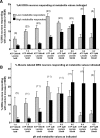Dorsal root ganglion neurons innervating skeletal muscle respond to physiological combinations of protons, ATP, and lactate mediated by ASIC, P2X, and TRPV1
- PMID: 18509077
- PMCID: PMC6195653
- DOI: 10.1152/jn.01344.2007
Dorsal root ganglion neurons innervating skeletal muscle respond to physiological combinations of protons, ATP, and lactate mediated by ASIC, P2X, and TRPV1
Abstract
The adequate stimuli and molecular receptors for muscle metaboreceptors and nociceptors are still under investigation. We used calcium imaging of cultured primary sensory dorsal root ganglion (DRG) neurons from C57Bl/6 mice to determine candidates for metabolites that could be the adequate stimuli and receptors that could detect these stimuli. Retrograde DiI labeling determined that some of these neurons innervated skeletal muscle. We found that combinations of protons, ATP, and lactate were much more effective than individually applied compounds for activating rapid calcium increases in muscle-innervating dorsal root ganglion neurons. Antagonists for P2X, ASIC, and TRPV1 receptors suggested that these three receptors act together to detect protons, ATP, and lactate when presented together in physiologically relevant concentrations. Two populations of muscle-innervating DRG neurons were found. One responded to low metabolite levels (likely nonnoxious) and used ASIC3, P2X5, and TRPV1 as molecular receptors to detect these metabolites. The other responded to high levels of metabolites (likely noxious) and used ASIC3, P2X4, and TRPV1 as their molecular receptors. We conclude that a combination of ASIC, P2X5 and/or P2X4, and TRPV1 are the molecular receptors used to detect metabolites by muscle-innervating sensory neurons. We further conclude that the adequate stimuli for muscle metaboreceptors and nociceptors are combinations of protons, ATP, and lactate.
Figures










Comment in
-
Receptor synergy from thin fiber muscle afferents. Focus on "Dorsal Root Ganglion Neurons Innervating Skeletal Muscle Respond to Physiological Combinations of Protons, ATP, and Lactate Mediated by ASIC, P2X, and TRPV1".J Neurophysiol. 2008 Sep;100(3):1169-70. doi: 10.1152/jn.90693.2008. Epub 2008 Jun 25. J Neurophysiol. 2008. PMID: 18579653 No abstract available.
References
-
- Adreani CM, Hill JM, Kaufman MP. Responses of group III and IV muscle afferents to dynamic exercise. J Appl Physiol : 1811–1817, 1997. - PubMed
-
- Adreani CM, Kaufman MP. Effect of arterial occlusion on responses of group III and IV afferents to dynamic exercise. J Appl Physiol : 1827–1833, 1998. - PubMed
-
- Arendt-Nielsen L, Mense S, Graven-Nielsen T. Assessment of muscle pain and hyperalgesia. Experimental and clinical findings. Schmerz : 445–449, 2003. - PubMed
Publication types
MeSH terms
Substances
Grants and funding
LinkOut - more resources
Full Text Sources
Other Literature Sources

